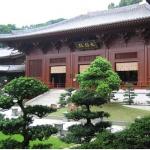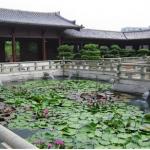Hong Kong's Chi Lin Nunnery
You can smell the Canadian cedar the minute you walk through the gate. I visited the Chi Lin Nunnery, the largest group of buildings in the world constructed entirely without nails. Nestled between two mountains, Chi Lin is home to some of Hong Kong’s one thousand ordained Buddhist nuns. Its 8-acre site features sixteen huge cedar halls each housing a statue of Buddha. There are courtyards with lotus ponds and classic Chinese gardens. The complex also houses clinics, homes, and activity and education centres for senior citizens and children. A vegetarian restaurant offers excellent food in an idyllic setting.
Chi Lin Nunnery is beautiful. The smell of the cedar wood temples mingles with burning incense and fragrant flowers. You can hear the chanting of the nuns praying in hidden rooms along the courtyard. Wind chimes hang from the corners of each building and their melodies are mixed with the mutterings of the people kneeling in front of the Buddhas and offering their petitions. The rushing of a waterfall intensifies the sound of streams gushing into the lotus ponds from the mouths of stone gargoyles. The glittering gold of the Buddha statues, the purples and pinks of the blooming water lilies, the bright orange of the fat carp darting in the ponds and the green new growth on the bonsai trees create a colorful montage.
The Chi Lin Nunnery was established nearly a hundred years ago but in the 1980’s the Hong Kong government decided to use it’s site to create a complex that would promote Chinese culture and encourage people not to forget the teachings of Buddha. They offered to provide the nuns with a new home that would allow them to continue to live together and do their charitable work but also reach out to the wider community. A choice was made to build the nunnery in the architectural style of the Tang Dynasty, a time of peace, great cultural growth and economic prosperity in China from 600-900 AD. Each hall at the Chi Lin Nunnery is a replica of a different famous temple located in one of China’s provinces. Models of these original temples are displayed in a museum on the nunnery site.
1000-year-old yellow cedar timber from Canada was shipped to Anhui province in China. Here skilled craftsmen created and put together all the components of the hall structures using an intricate system of dowels and brackets, rather than nails. The completed rafters and pillars were transported to Hong Kong and assembled like a jig-saw-puzzle to form the impressive nunnery halls. The whole project took ten years and $100 million Canadian to finish.
The Chi Lin Nunnery is listed as a ‘must see’ in many guidebooks. The day I was there a young man from Switzerland was touring the site. Since I was the only other Caucasian visitor he approached me and began to ask questions. He wanted to find out more about the nunnery but didn’t understand all the English words on the wooden signs around the complex. I tried to help explain their meanings.
The woman who sold me a souvenir booklet smiled broadly when I told her I was orginally from Canada and assured me our Canadian trees had been used for a good purpose in the building of Chi Lin. “Using wood to build a temple” she told me, “is a way to lengthen the life of the tree and the tree in turn brings life to the temple.” She claimed Chi Lin was so well built it would last at least 500 years. Its kind of neat to know a little part of my home and native land will live on in Hong Kong for the next five centuries or so.
 ThingsAsian
ThingsAsian




















